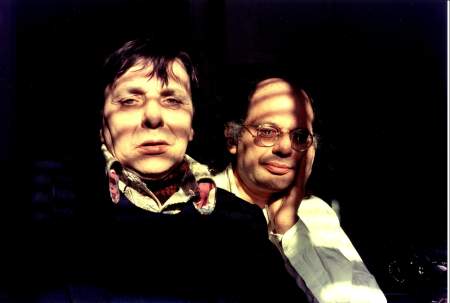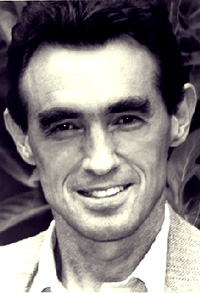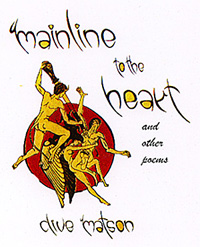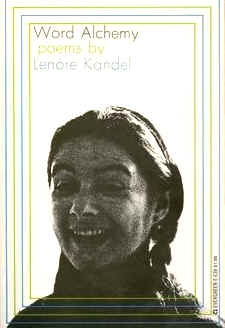
| Jacket 37 — Early 2009 | Jacket 37 Contents page | Jacket Homepage | Search Jacket |
The Internet address of this page is http://jacketmagazine.com/37/r-matson-rb-ring.shtml
Clive Matson
Mainline to the Heart
reviewed by Kevin Ring
Regent Press, 2747 Regent Street, Berkeley, California, 94705, USA
http://www.regentpress.net/ e-mail regentpress [AT] mindspring.com Larger format softcover at $22: ISBN 978-1587901393
This review is about 4 printed pages long.
It is copyright © Kevin Ring and Jacket magazine 2009.
See our [»»] copyright notice.
1
Forty-three years after these totally explicit poems were first thrust upon a world freeing itself from a censorship that had stifled everything, Clive Matson’s Mainline to the Heart is recently reissued with some additional poems gathered from small publications of the time, di Prima’s Floating Bear, and also Intrepid published by Allen De Loach — among others. And at that time, 1966, this edition of one thousand copies must have delighted and shocked in equal measure. The daring honesty and chaos of a drug- and sex-saturated life revealed, the starkness of the sexual frankness must have captured the eyes and ears of those liberated souls of that flower era, if it can still be remembered as such.
Paragraph 2
Willed into life by the freshly acquired skills of budding printer Diane di Prima and her Poets Press, Matson and his young wife Erin had encountered her at the Tenth Street Coffeehouse in New York, with Gregory Corso and Allen Ginsberg. It was a collision that changed his life, and the sliding doors slid his way. Matson has gone on record as saying of these connections ‘Ginsberg spoke directly to the alienation of the young, to the appeal of drugs, to sexual uncertainty, and he countered these downward pulls with a vibrant sense of adventure.’ Matson seemed to embrace the hedonistic atmosphere of the times more than most. Mainline to the Heart is the tangible literary manifestation of his experiences at that time.

Herbert Huncke, Allen Ginsberg, near window of Ginsberg’s E. 12th Street apartment, New Year’s 1976. Photo Copyright © Gordon Ball, 2006.
3
Coming to New York City from Southern California and a rural life, the young Matson found the Beats like glowing icons. Beat luminaries like Times Square hustler Herbert Huncke were to become mentors to him. Did he realise what he was doing back then? The idea of Herbert Huncke, for all his commendable qualities, as something of a father figure is a difficult one to get a handle on – though in recent years Matson has expressed the sentiment that to sum up his life so far he would print Herbert Huncke’s face on a tee shirt and emblazon the words under it: What’s Your Passion?
4
The admiration is undimmed, even though Huncke was part of a circle that led him into a drug hell – though whether Matson would view it that way is debatable. It seems from these poems that he both revelled in it and reviled himself. That drugged era is partly responsible for the poems in this volume, that and the heady atmosphere around him. The drugs and a keen desire to explore who he was, regardless of what he found, fired him on.

Clive Matson
5
While James Joyce’s Portrait of the Artist was an early inspiration, Matson says ‘Writing my first poem gave me a sense of joy and authenticity. I’ve been following that powerful feeling my whole life. I wrote about the wind blowing through chaparral hills. Maybe it was for only two days, but it seemed the words rolled around my mind for weeks.’
6
Mainline to the Heart is not an especially pretty book, you will not especially like the poet who bares all in the quest for his truth. He is used, and he is a user. With a leering sneer he dismisses the line of women in his bed, fantasizing on the next conquest. The reader might well feel that this is one sick poet with murderous thoughts – it is all so sinister. But he stays with it, a communication from the frontline of experience, from the depths of the abyss. I’m put in mind of the early controversial poems of Lenore Kandel*. She seems sadly defined by those initial published works. Whether Matson has suffered this way is open to debate.

7
John Wieners, another poetical mentor, wrote the introduction at the time of first publication. It is again included here. Diane di Prima pens a fresh Afterword. The continuity of it all is flawless.
8
Perhaps in these less restrictive times, speaking relatively, Matson’s youthful work can be appreciated with new eyes. As someone once said: ‘Ladies and gentlemen, lift up your skirts. You are going through some kind of hell.’

Lenore Kandel book cover
* Lenore Kandel (born 1932) is a poet who was briefly notorious as the author of a short book of poetry, The Love Book, a small pamphlet of 8 pages with 4 poems, including “To Fuck with Love” which was prosecuted for obscenity in 1967 in San Francisco during the hippie movement in Haight-Ashbury. She was a speaker at the Human Be-In in Golden Gate Park, January 14, 1967. She was one of 15 people interviewed in “Voices from the Love Generation”". — Wikipedia